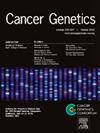lncRNA SSTR5-AS1通过募集STAT3调控SLC7A11表达促进卵巢癌细胞耐铁凋亡和免疫逃逸的机制
IF 2.1
4区 医学
Q4 GENETICS & HEREDITY
引用次数: 0
摘要
目的卵巢癌(OC)是妇科肿瘤相关死亡的首要原因。考虑到长链非编码rna (lncRNAs)在恶性肿瘤中的作用,我们探索了SSTR5-AS1通过转录3信号换能器和激活器(STAT3)/溶质载体家族7a成员11 (SLC7A11)轴调控OC细胞铁凋亡抵抗和免疫逃逸的机制。方法采用si-SSTR5-AS1、oe-SSTR5-AS1和oe-SLC7A11质粒处理soc细胞。采用RT-qPCR、CCK-8、Transwell检测SSTR5-AS1、STAT3、SLC7A11 mRNA表达水平及细胞恶性行为。采用试剂盒、CCK-8和流式细胞术检测erastin诱导OC细胞中Fe2+、谷胱甘肽(GSH)和丙二醛(MDA)水平,以及OC细胞共培养CD8+T细胞的活力和凋亡。亚细胞分离法检测SSTR5-AS1的分布。Western blot检测STAT3和SLC7A11蛋白水平。通过数据库预测SSTR5-AS1和STAT3之间的蛋白相互作用和结合关系,并通过RIP和双荧光素酶实验进行验证。结果ssstr5 - as1在OC细胞中表达上调。SSTR5-AS1过表达可促进OC细胞的恶性行为,下调erastin处理OC细胞的Fe2+和MDA水平,上调GSH水平,降低OC细胞共培养CD8+T细胞的活力,增强凋亡,提示SSTR5-AS1过表达促进OC细胞对铁凋亡的抵抗和免疫逃逸,而这一过程被其下调抑制。SSTR5-AS1通过募集STAT3促进SLC7A11的转录和表达。SLC7A11过表达部分逆转了SSTR5-AS1敲低对OC细胞的影响。结论sstr5 - as1通过募集STAT3促进SLC7A11的转录和表达,从而促进OC细胞对铁下垂的抵抗和免疫逃逸。本文章由计算机程序翻译,如有差异,请以英文原文为准。
The mechanism of lncRNA SSTR5-AS1 promoting ferroptosis resistance and immune escape in ovarian cancer cells by recruiting STAT3 to regulate SLC7A11 expression
Objective
Ovarian cancer (OC) is the foremost cause of gynecological cancer-related mortality. Respecting the role of long noncoding RNAs (lncRNAs) in malignancies, we explored the mechanism of SSTR5-AS1 regulating OC cell ferroptosis resistance and immune escape via the signal transducer and activator of transcription 3 (STAT3)/solute carrier family 7a member 11 (SLC7A11) axis.
Methods
OC cells were treated with si-SSTR5-AS1, oe-SSTR5-AS1 and oe-SLC7A11 plasmids. SSTR5-AS1, STAT3 and SLC7A11 mRNA levels, and cell malignant behaviors were assessed by RT-qPCR, CCK-8 and Transwell assays. Fe2+, glutathione (GSH) and malondialdehyde (MDA) levels in Erastin-induced OC cells, and viability and apoptosis in OC cell-co-cultured CD8+T cells were determined using kits, and CCK-8 and flow cytometry. SSTR5-AS1 distribution was detected by subcellular fractionation assay. STAT3 and SLC7A11 protein levels were measured by Western blot. The protein interaction and binding relationship between SSTR5-AS1 and STAT3 were predicted by database and confirmed using RIP and verified using dual-luciferase assays.
Results
SSTR5-AS1 was up-regulated in OC cells. SSTR5-AS1 overexpression facilitated OC cell malignant behaviors, down-regulated Fe2+ and MDA levels and up-regulated the GSH level in Erastin-treated OC cells, and diminished viability and enhanced apoptosis in OC cell-co-cultured CD8+T cells, suggesting that SSTR5-AS1 overexpression promoted OC cell ferroptosis resistance and immune escape, which were inhibited by its downregulation. SSTR5-AS1 facilitated SLC7A11 transcription and expression by recruiting STAT3. SLC7A11 overexpression partially reversed the effects of SSTR5-AS1 knockdown on OC cells.
Conclusion
SSTR5-AS1 promoted SLC7A11 transcription and expression by recruiting STAT3, thereby promoting ferroptosis resistance and immune escape of OC cells.
求助全文
通过发布文献求助,成功后即可免费获取论文全文。
去求助
来源期刊

Cancer Genetics
ONCOLOGY-GENETICS & HEREDITY
CiteScore
3.20
自引率
5.30%
发文量
167
审稿时长
27 days
期刊介绍:
The aim of Cancer Genetics is to publish high quality scientific papers on the cellular, genetic and molecular aspects of cancer, including cancer predisposition and clinical diagnostic applications. Specific areas of interest include descriptions of new chromosomal, molecular or epigenetic alterations in benign and malignant diseases; novel laboratory approaches for identification and characterization of chromosomal rearrangements or genomic alterations in cancer cells; correlation of genetic changes with pathology and clinical presentation; and the molecular genetics of cancer predisposition. To reach a basic science and clinical multidisciplinary audience, we welcome original full-length articles, reviews, meeting summaries, brief reports, and letters to the editor.
 求助内容:
求助内容: 应助结果提醒方式:
应助结果提醒方式:


